7315MED Applied Ethics & Law: A Case Study on End-of-Life Decisions
VerifiedAdded on 2023/06/09
|7
|1266
|235
Essay
AI Summary
This essay discusses ethical decision-making in healthcare management, focusing on a case study where a patient's family chooses to conceal a terminal diagnosis due to cultural beliefs. The analysis is based on the Singapore Nursing Board's Code for Nurses and Midwives, particularly principles related to respecting patient values, needs, rights, and autonomy. The essay argues that while cultural sensitivity is important, healthcare professionals should prioritize patient autonomy and informed decision-making. It further explores the rationale behind respecting patient choices, even when conflicting with personal or professional beliefs, emphasizing the importance of trust in the patient-nurse relationship. The conclusion underscores the necessity for nurses to integrate clinical expertise with moral judgments, using ethical guidelines to navigate complex dilemmas.
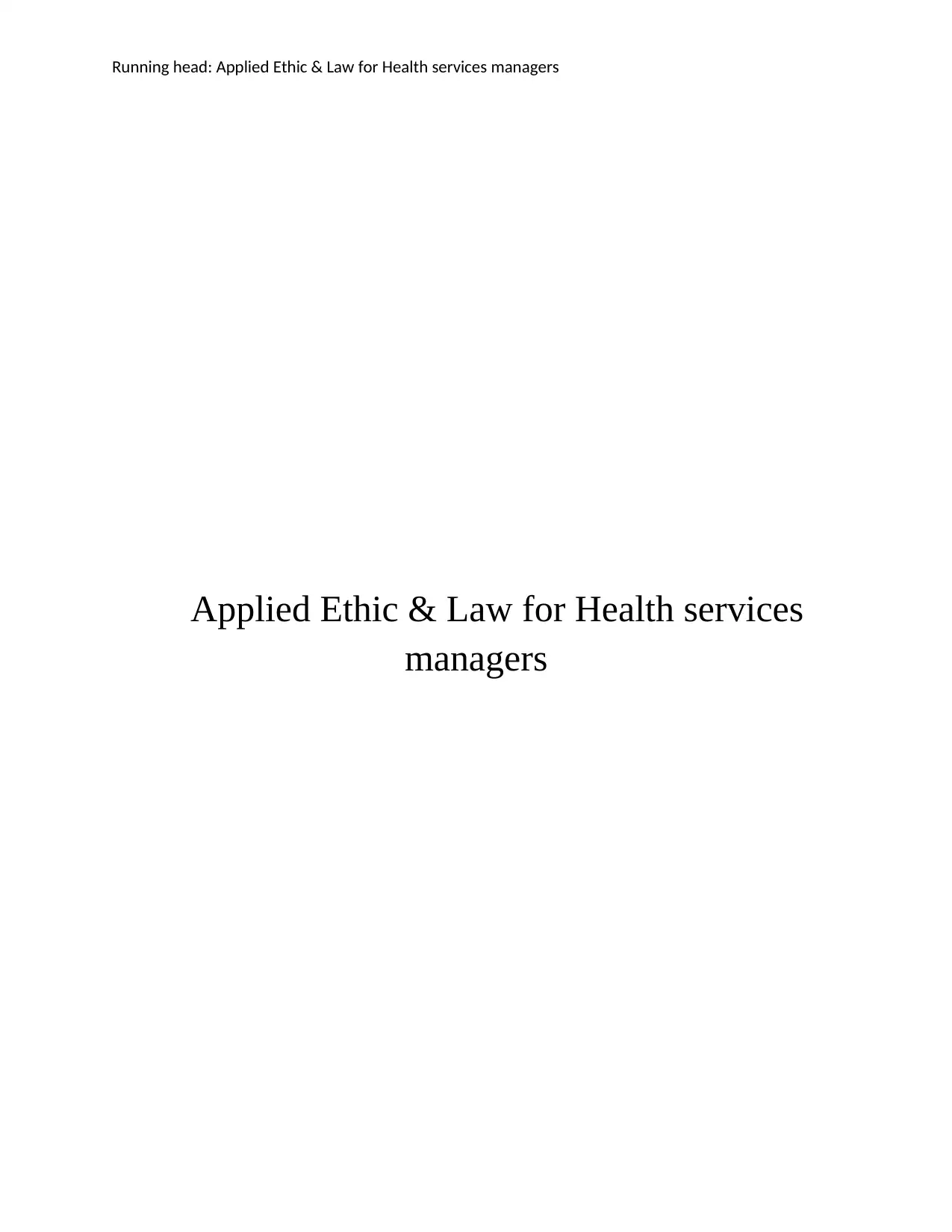
Running head: Applied Ethic & Law for Health services managers
Applied Ethic & Law for Health services
managers
Applied Ethic & Law for Health services
managers
Paraphrase This Document
Need a fresh take? Get an instant paraphrase of this document with our AI Paraphraser
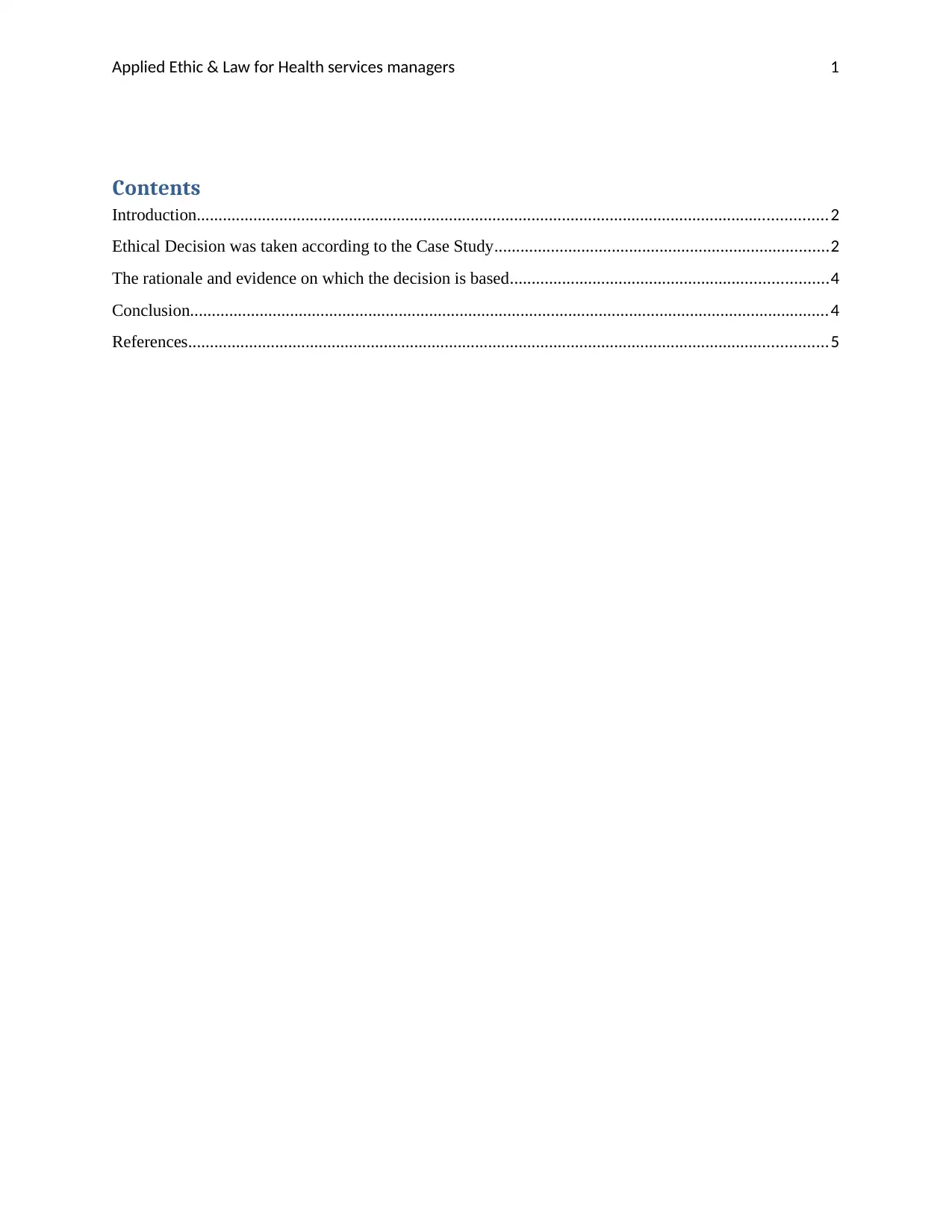
Applied Ethic & Law for Health services managers 1
Contents
Introduction.................................................................................................................................................2
Ethical Decision was taken according to the Case Study.............................................................................2
The rationale and evidence on which the decision is based.........................................................................4
Conclusion...................................................................................................................................................4
References...................................................................................................................................................5
Contents
Introduction.................................................................................................................................................2
Ethical Decision was taken according to the Case Study.............................................................................2
The rationale and evidence on which the decision is based.........................................................................4
Conclusion...................................................................................................................................................4
References...................................................................................................................................................5
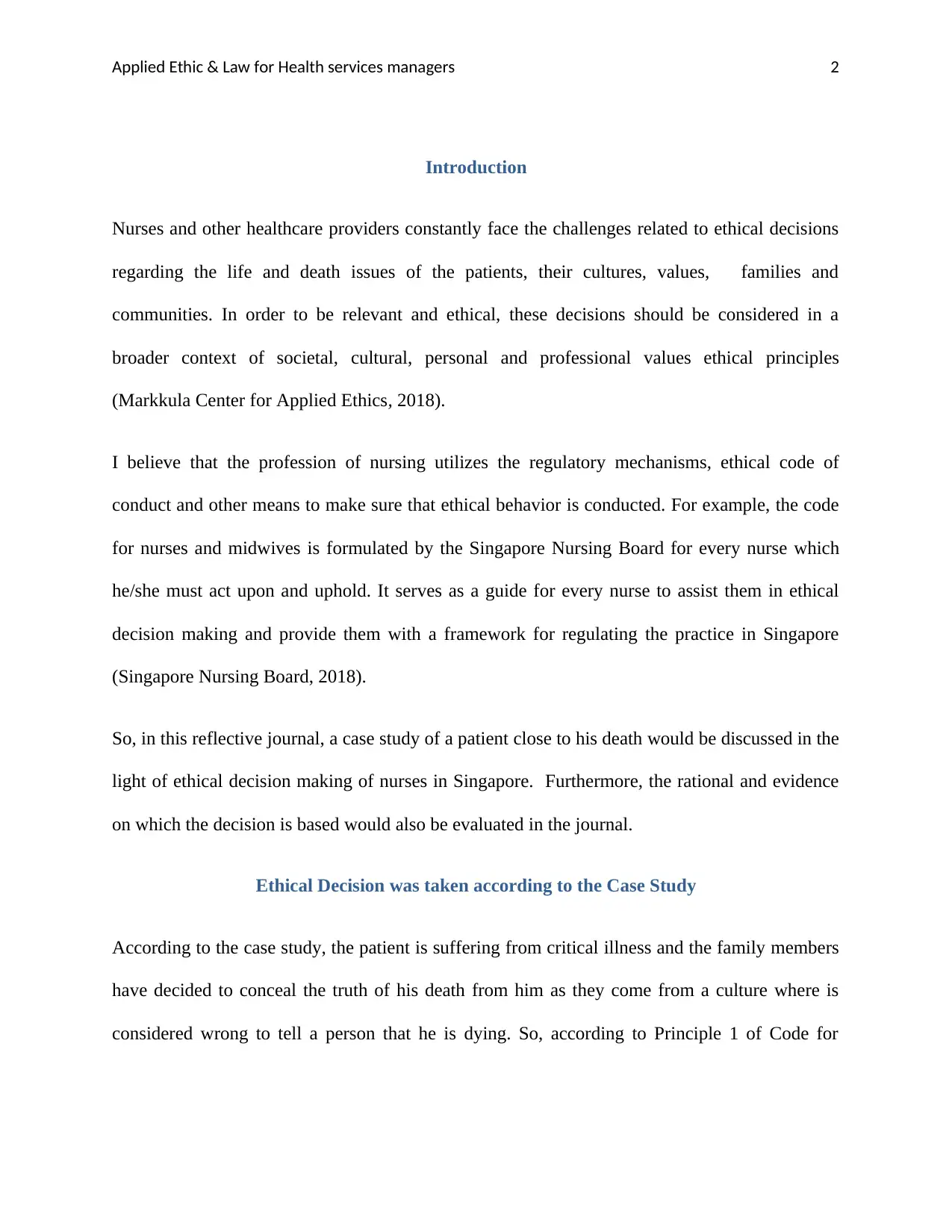
Applied Ethic & Law for Health services managers 2
Introduction
Nurses and other healthcare providers constantly face the challenges related to ethical decisions
regarding the life and death issues of the patients, their cultures, values, families and
communities. In order to be relevant and ethical, these decisions should be considered in a
broader context of societal, cultural, personal and professional values ethical principles
(Markkula Center for Applied Ethics, 2018).
I believe that the profession of nursing utilizes the regulatory mechanisms, ethical code of
conduct and other means to make sure that ethical behavior is conducted. For example, the code
for nurses and midwives is formulated by the Singapore Nursing Board for every nurse which
he/she must act upon and uphold. It serves as a guide for every nurse to assist them in ethical
decision making and provide them with a framework for regulating the practice in Singapore
(Singapore Nursing Board, 2018).
So, in this reflective journal, a case study of a patient close to his death would be discussed in the
light of ethical decision making of nurses in Singapore. Furthermore, the rational and evidence
on which the decision is based would also be evaluated in the journal.
Ethical Decision was taken according to the Case Study
According to the case study, the patient is suffering from critical illness and the family members
have decided to conceal the truth of his death from him as they come from a culture where is
considered wrong to tell a person that he is dying. So, according to Principle 1 of Code for
Introduction
Nurses and other healthcare providers constantly face the challenges related to ethical decisions
regarding the life and death issues of the patients, their cultures, values, families and
communities. In order to be relevant and ethical, these decisions should be considered in a
broader context of societal, cultural, personal and professional values ethical principles
(Markkula Center for Applied Ethics, 2018).
I believe that the profession of nursing utilizes the regulatory mechanisms, ethical code of
conduct and other means to make sure that ethical behavior is conducted. For example, the code
for nurses and midwives is formulated by the Singapore Nursing Board for every nurse which
he/she must act upon and uphold. It serves as a guide for every nurse to assist them in ethical
decision making and provide them with a framework for regulating the practice in Singapore
(Singapore Nursing Board, 2018).
So, in this reflective journal, a case study of a patient close to his death would be discussed in the
light of ethical decision making of nurses in Singapore. Furthermore, the rational and evidence
on which the decision is based would also be evaluated in the journal.
Ethical Decision was taken according to the Case Study
According to the case study, the patient is suffering from critical illness and the family members
have decided to conceal the truth of his death from him as they come from a culture where is
considered wrong to tell a person that he is dying. So, according to Principle 1 of Code for
⊘ This is a preview!⊘
Do you want full access?
Subscribe today to unlock all pages.

Trusted by 1+ million students worldwide
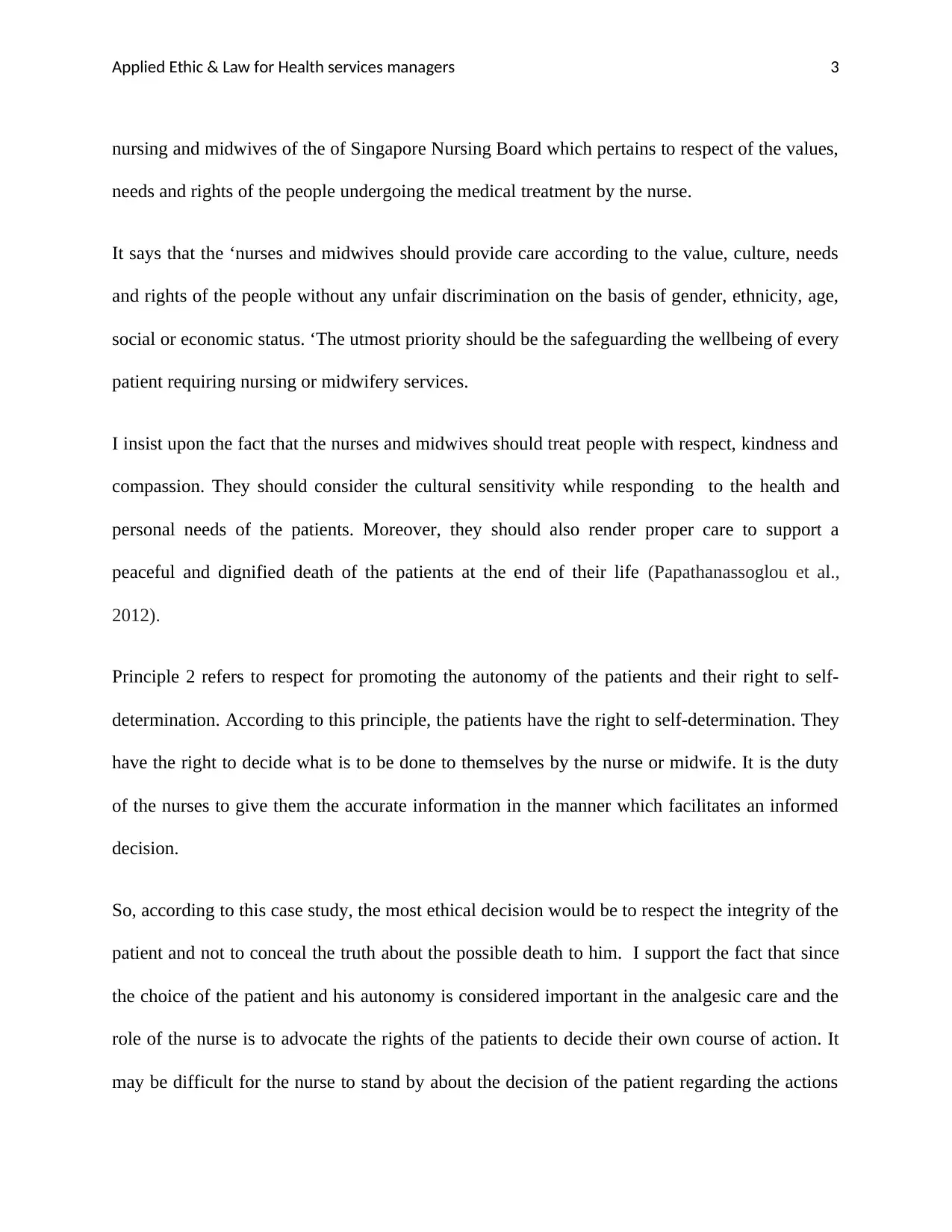
Applied Ethic & Law for Health services managers 3
nursing and midwives of the of Singapore Nursing Board which pertains to respect of the values,
needs and rights of the people undergoing the medical treatment by the nurse.
It says that the ‘nurses and midwives should provide care according to the value, culture, needs
and rights of the people without any unfair discrimination on the basis of gender, ethnicity, age,
social or economic status. ‘The utmost priority should be the safeguarding the wellbeing of every
patient requiring nursing or midwifery services.
I insist upon the fact that the nurses and midwives should treat people with respect, kindness and
compassion. They should consider the cultural sensitivity while responding to the health and
personal needs of the patients. Moreover, they should also render proper care to support a
peaceful and dignified death of the patients at the end of their life (Papathanassoglou et al.,
2012).
Principle 2 refers to respect for promoting the autonomy of the patients and their right to self-
determination. According to this principle, the patients have the right to self-determination. They
have the right to decide what is to be done to themselves by the nurse or midwife. It is the duty
of the nurses to give them the accurate information in the manner which facilitates an informed
decision.
So, according to this case study, the most ethical decision would be to respect the integrity of the
patient and not to conceal the truth about the possible death to him. I support the fact that since
the choice of the patient and his autonomy is considered important in the analgesic care and the
role of the nurse is to advocate the rights of the patients to decide their own course of action. It
may be difficult for the nurse to stand by about the decision of the patient regarding the actions
nursing and midwives of the of Singapore Nursing Board which pertains to respect of the values,
needs and rights of the people undergoing the medical treatment by the nurse.
It says that the ‘nurses and midwives should provide care according to the value, culture, needs
and rights of the people without any unfair discrimination on the basis of gender, ethnicity, age,
social or economic status. ‘The utmost priority should be the safeguarding the wellbeing of every
patient requiring nursing or midwifery services.
I insist upon the fact that the nurses and midwives should treat people with respect, kindness and
compassion. They should consider the cultural sensitivity while responding to the health and
personal needs of the patients. Moreover, they should also render proper care to support a
peaceful and dignified death of the patients at the end of their life (Papathanassoglou et al.,
2012).
Principle 2 refers to respect for promoting the autonomy of the patients and their right to self-
determination. According to this principle, the patients have the right to self-determination. They
have the right to decide what is to be done to themselves by the nurse or midwife. It is the duty
of the nurses to give them the accurate information in the manner which facilitates an informed
decision.
So, according to this case study, the most ethical decision would be to respect the integrity of the
patient and not to conceal the truth about the possible death to him. I support the fact that since
the choice of the patient and his autonomy is considered important in the analgesic care and the
role of the nurse is to advocate the rights of the patients to decide their own course of action. It
may be difficult for the nurse to stand by about the decision of the patient regarding the actions
Paraphrase This Document
Need a fresh take? Get an instant paraphrase of this document with our AI Paraphraser
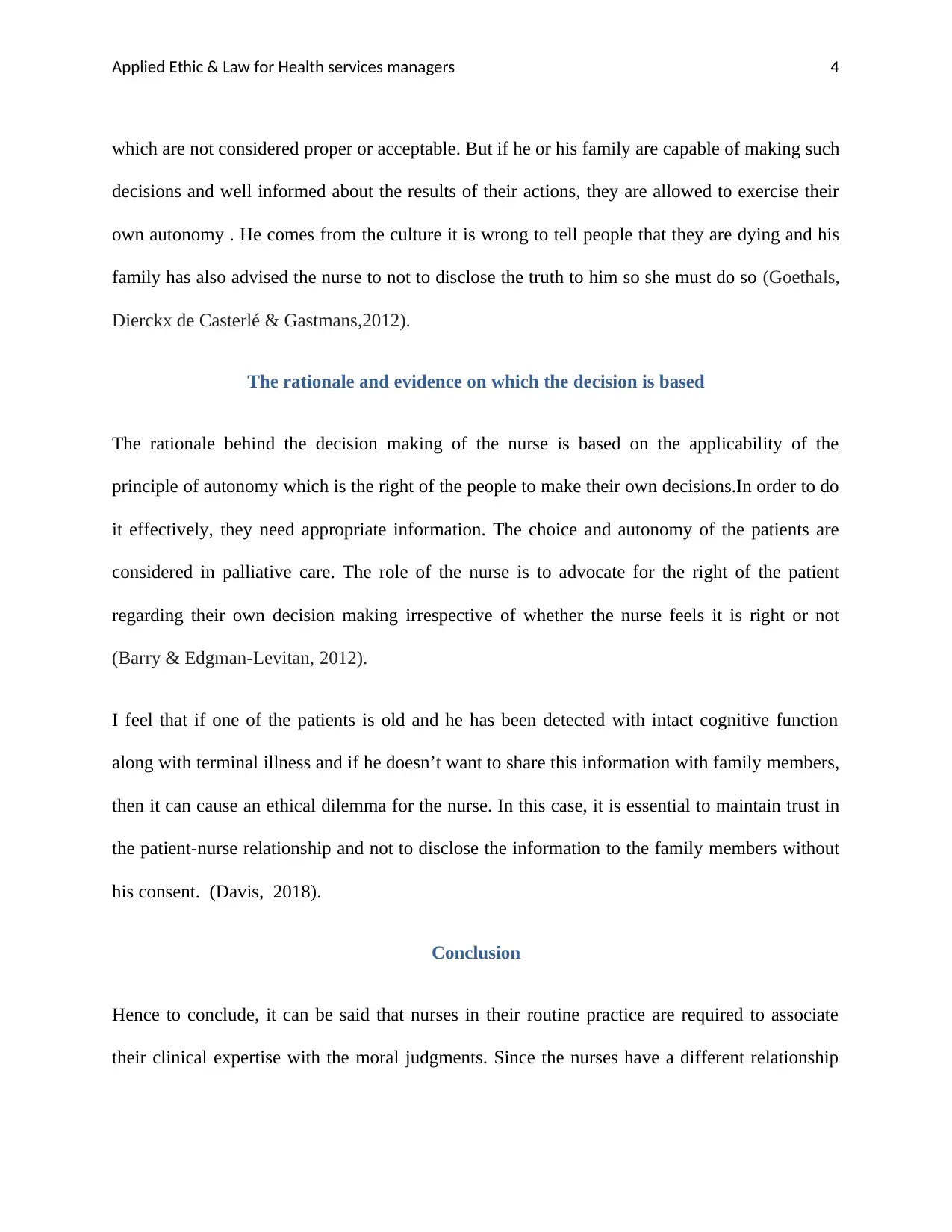
Applied Ethic & Law for Health services managers 4
which are not considered proper or acceptable. But if he or his family are capable of making such
decisions and well informed about the results of their actions, they are allowed to exercise their
own autonomy . He comes from the culture it is wrong to tell people that they are dying and his
family has also advised the nurse to not to disclose the truth to him so she must do so (Goethals,
Dierckx de Casterlé & Gastmans,2012).
The rationale and evidence on which the decision is based
The rationale behind the decision making of the nurse is based on the applicability of the
principle of autonomy which is the right of the people to make their own decisions.In order to do
it effectively, they need appropriate information. The choice and autonomy of the patients are
considered in palliative care. The role of the nurse is to advocate for the right of the patient
regarding their own decision making irrespective of whether the nurse feels it is right or not
(Barry & Edgman-Levitan, 2012).
I feel that if one of the patients is old and he has been detected with intact cognitive function
along with terminal illness and if he doesn’t want to share this information with family members,
then it can cause an ethical dilemma for the nurse. In this case, it is essential to maintain trust in
the patient-nurse relationship and not to disclose the information to the family members without
his consent. (Davis, 2018).
Conclusion
Hence to conclude, it can be said that nurses in their routine practice are required to associate
their clinical expertise with the moral judgments. Since the nurses have a different relationship
which are not considered proper or acceptable. But if he or his family are capable of making such
decisions and well informed about the results of their actions, they are allowed to exercise their
own autonomy . He comes from the culture it is wrong to tell people that they are dying and his
family has also advised the nurse to not to disclose the truth to him so she must do so (Goethals,
Dierckx de Casterlé & Gastmans,2012).
The rationale and evidence on which the decision is based
The rationale behind the decision making of the nurse is based on the applicability of the
principle of autonomy which is the right of the people to make their own decisions.In order to do
it effectively, they need appropriate information. The choice and autonomy of the patients are
considered in palliative care. The role of the nurse is to advocate for the right of the patient
regarding their own decision making irrespective of whether the nurse feels it is right or not
(Barry & Edgman-Levitan, 2012).
I feel that if one of the patients is old and he has been detected with intact cognitive function
along with terminal illness and if he doesn’t want to share this information with family members,
then it can cause an ethical dilemma for the nurse. In this case, it is essential to maintain trust in
the patient-nurse relationship and not to disclose the information to the family members without
his consent. (Davis, 2018).
Conclusion
Hence to conclude, it can be said that nurses in their routine practice are required to associate
their clinical expertise with the moral judgments. Since the nurses have a different relationship
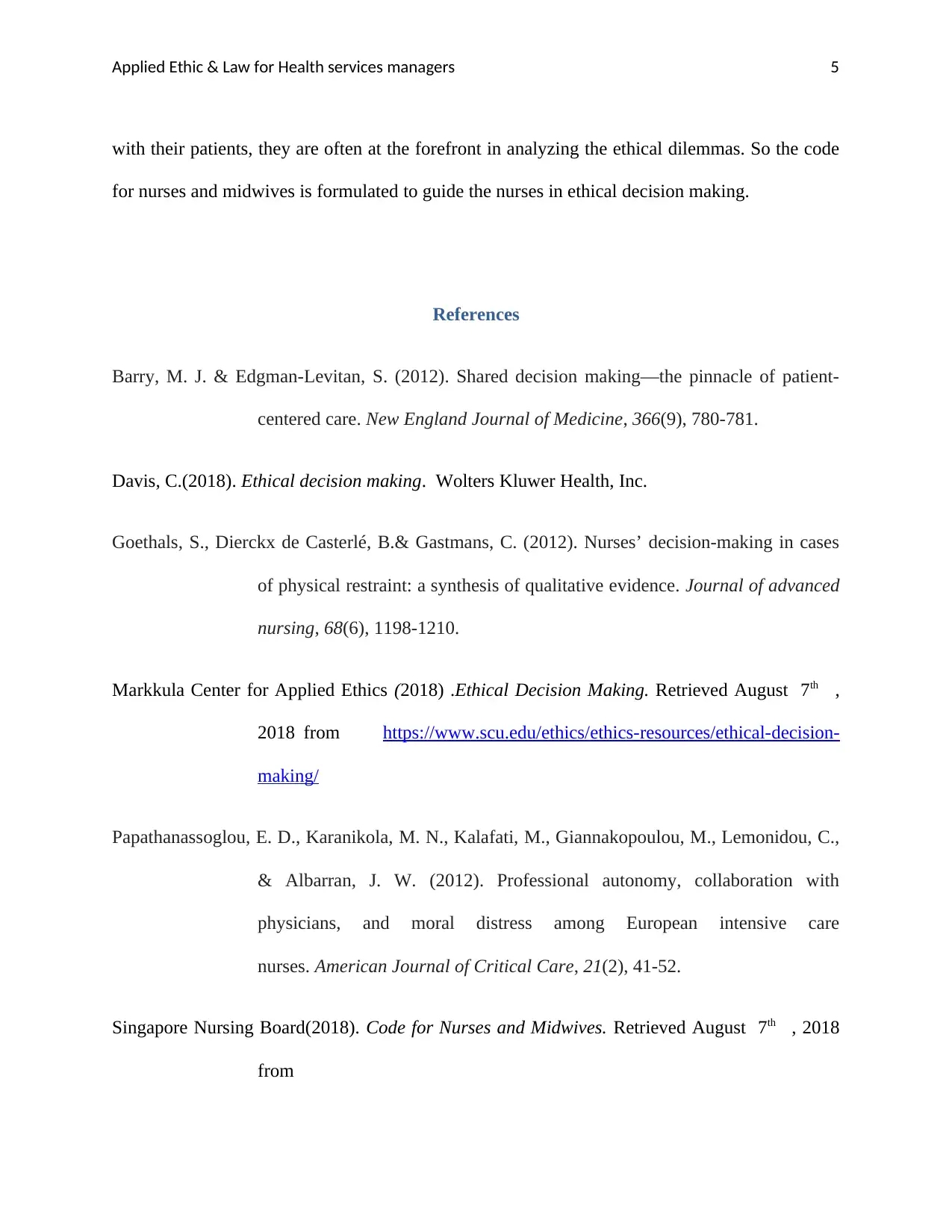
Applied Ethic & Law for Health services managers 5
with their patients, they are often at the forefront in analyzing the ethical dilemmas. So the code
for nurses and midwives is formulated to guide the nurses in ethical decision making.
References
Barry, M. J. & Edgman-Levitan, S. (2012). Shared decision making—the pinnacle of patient-
centered care. New England Journal of Medicine, 366(9), 780-781.
Davis, C.(2018). Ethical decision making. Wolters Kluwer Health, Inc.
Goethals, S., Dierckx de Casterlé, B.& Gastmans, C. (2012). Nurses’ decision‐making in cases
of physical restraint: a synthesis of qualitative evidence. Journal of advanced
nursing, 68(6), 1198-1210.
Markkula Center for Applied Ethics (2018) .Ethical Decision Making. Retrieved August 7th ,
2018 from https://www.scu.edu/ethics/ethics-resources/ethical-decision-
making/
Papathanassoglou, E. D., Karanikola, M. N., Kalafati, M., Giannakopoulou, M., Lemonidou, C.,
& Albarran, J. W. (2012). Professional autonomy, collaboration with
physicians, and moral distress among European intensive care
nurses. American Journal of Critical Care, 21(2), 41-52.
Singapore Nursing Board(2018). Code for Nurses and Midwives. Retrieved August 7th , 2018
from
with their patients, they are often at the forefront in analyzing the ethical dilemmas. So the code
for nurses and midwives is formulated to guide the nurses in ethical decision making.
References
Barry, M. J. & Edgman-Levitan, S. (2012). Shared decision making—the pinnacle of patient-
centered care. New England Journal of Medicine, 366(9), 780-781.
Davis, C.(2018). Ethical decision making. Wolters Kluwer Health, Inc.
Goethals, S., Dierckx de Casterlé, B.& Gastmans, C. (2012). Nurses’ decision‐making in cases
of physical restraint: a synthesis of qualitative evidence. Journal of advanced
nursing, 68(6), 1198-1210.
Markkula Center for Applied Ethics (2018) .Ethical Decision Making. Retrieved August 7th ,
2018 from https://www.scu.edu/ethics/ethics-resources/ethical-decision-
making/
Papathanassoglou, E. D., Karanikola, M. N., Kalafati, M., Giannakopoulou, M., Lemonidou, C.,
& Albarran, J. W. (2012). Professional autonomy, collaboration with
physicians, and moral distress among European intensive care
nurses. American Journal of Critical Care, 21(2), 41-52.
Singapore Nursing Board(2018). Code for Nurses and Midwives. Retrieved August 7th , 2018
from
⊘ This is a preview!⊘
Do you want full access?
Subscribe today to unlock all pages.

Trusted by 1+ million students worldwide
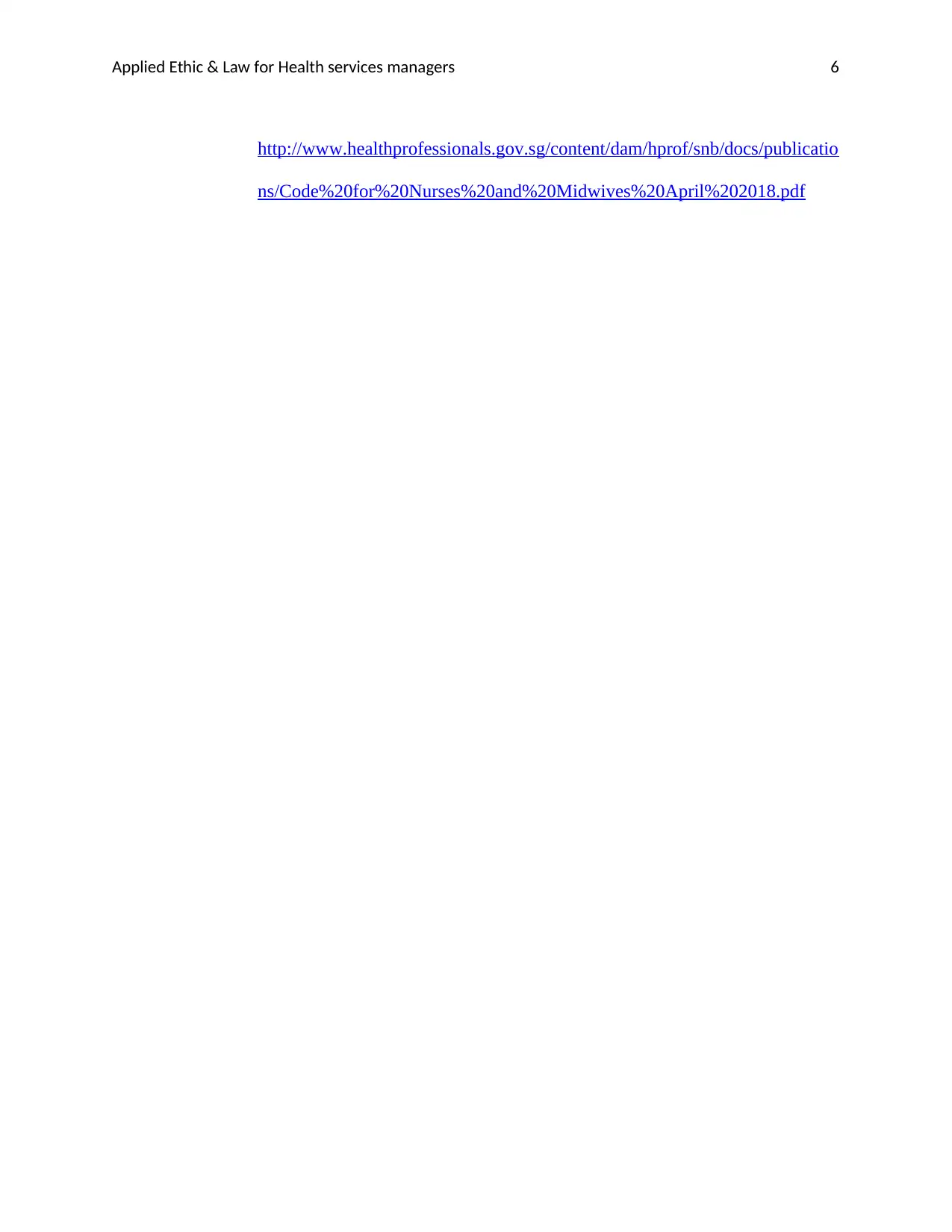
Applied Ethic & Law for Health services managers 6
http://www.healthprofessionals.gov.sg/content/dam/hprof/snb/docs/publicatio
ns/Code%20for%20Nurses%20and%20Midwives%20April%202018.pdf
http://www.healthprofessionals.gov.sg/content/dam/hprof/snb/docs/publicatio
ns/Code%20for%20Nurses%20and%20Midwives%20April%202018.pdf
1 out of 7
Related Documents
Your All-in-One AI-Powered Toolkit for Academic Success.
+13062052269
info@desklib.com
Available 24*7 on WhatsApp / Email
![[object Object]](/_next/static/media/star-bottom.7253800d.svg)
Unlock your academic potential
Copyright © 2020–2025 A2Z Services. All Rights Reserved. Developed and managed by ZUCOL.





